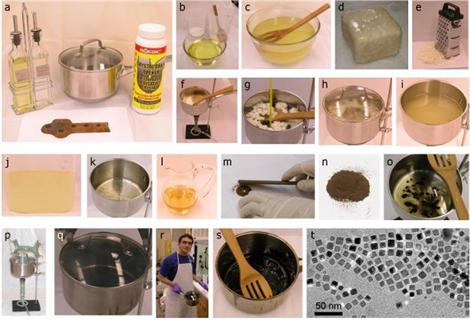
Unlike many chemistry projects we post here, making magnetite nanocrystals doesn’t require anything that can’t be found in a local grocery store. All that is required is oil, vinegar, crystal drain opener, and rust. We don’t recognize the specific brand of drain cleaner that they are using, but we’re sure that you could find one with the same ingredients. Magnetite nanocrystals are used to remove arsenic from water. If you are in the USA or most of Europe, that’s not a big concern, but it can’t hurt can it?
[via Make]














Ferrofluid ftw.
I have tried this method before though, and your ff wont last too long.
I like how the justification is using it to remove arsensic, but they don’t tell you how to use it to remove arsenic….
The “drain cleaner” pictured is 100% lye (sodium hydroxide). So it doesn’t matter the brand, as long as it is lye. But please do be careful and use eye and skin protection.
And what makes that homemade soap different from regular soap?
I’ve found that the glicerine formed and all the humidity in the soap will take several days to dry. Then could be able to grind it without ending with goo.
@Insipid Melon
You throw the magnetite into a bucket with the water you want to clean, swirl it around for a few minutes, place a magnet underneath the bucket, allow the magnetite particles to settle, and pour out your clean water.
This is one of those bits of knowledge that would be useful if you got stranded in the past due to a burnt out flux capacitor.
Then again, a little arsenic would probably be the least of your water-cleanliness worries.
Oil, lye, rust and a big ass magnet? This could be useful in Bangladesh.
hmm..
Now that would be cool if the crystals could be filtered and then attached to small grains of white paint. Homemade e-ink anyone?
Nice to see there are some chemists left, long may it continue. Hopefully the Govt will realise that crippling science by underfunding/draconian laws is a bad economy move.
Concentrated ammonia should do the same trick if you dont have any lye… the most interresting thing though is the oil present since its gonna work as a ligand for stabilizing the nanoparticles.
if the particles wont dissolve, try some oil with shorter chainlength if you want it to fully dissolve in the water
@Mowgli: Actually ferrofluid can be prepared with almost every Lye as long as the pH is high enough.
We did it with 0,7M Ammonia Hydroxide and it worked quite well.
See 1:05 for reference: http://www.youtube.com/watch?v=JhqBV4LOBjM
So normal Ammonium hydroxide that can be bought in stores is way higher concentrated. we didn’t try with sodium carbonate, sodium acetate or something like that, but I think that could be already alkaline enough to start the reaction.
On the other hand if you want Ferrofluid that can be used for the famous effect, you cant just use rust to prepare it, we used highly pure chemicals in and failed to get spikes.
Nice one. Hetre is a tip. be sure the Ferric Chloride is reduced to Ferrous chloride (via wire wool) turns green..(must be) or your yeild will be low. Like you web site